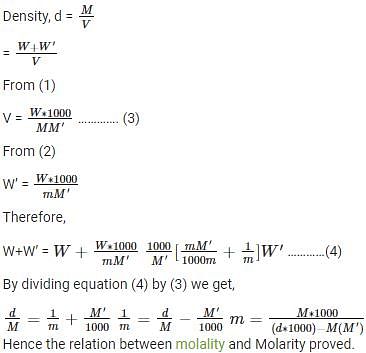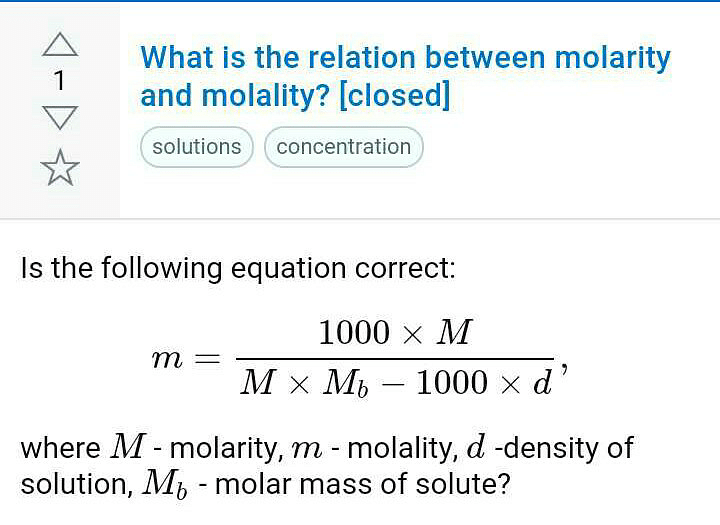NEET Exam > NEET Questions > Relation between molarity and molality ??
Start Learning for Free
Relation between molarity and molality ??
Verified Answer
Relation between molarity and molality ??
Relation Between Molarity And Molality:
Let the mass of given solute be W.
Let the volume of the solution be V.
Let the molality be m.
Let the molar mass of solute be M’.
Let the Molarity be M.
Let the weight of the solvent be W’.




 This question is part of UPSC exam. View all NEET courses
This question is part of UPSC exam. View all NEET courses
Most Upvoted Answer
Relation between molarity and molality ??

Community Answer
Relation between molarity and molality ??
Molarity and Molality: Understanding the Relation
Molarity and molality are both units of concentration used in chemistry to express the amount of solute dissolved in a given amount of solvent. While they are similar in concept, there are key differences between the two. In this explanation, we will explore the relation between molarity and molality and clarify their definitions, formulas, and applications.
Molarity (M) is a measure of the concentration of a solute in a solution, expressed as the number of moles of solute per liter of solution. It is the most commonly used unit of concentration in chemistry laboratories.
Key points about molarity:
- Molarity is defined as the moles of solute divided by the volume of the solution in liters.
- The formula for calculating molarity is M = moles of solute / volume of solution (in liters).
- Molarity is temperature-dependent as it is based on the volume of the solution.
- It is represented by the symbol "M."
Molality (m) is another unit of concentration that measures the amount of solute in a given amount of solvent. It is defined as the number of moles of solute per kilogram of solvent. Unlike molarity, molality remains constant regardless of temperature changes.
Key points about molality:
- Molality is defined as the moles of solute divided by the mass of the solvent in kilograms.
- The formula for calculating molality is m = moles of solute / mass of solvent (in kilograms).
- Molality is temperature-independent, making it useful in certain experiments and calculations.
- It is represented by the symbol "m."
The relation between molarity and molality can be understood through a simple equation involving density:
Molarity = Molality × Density × (Molar Mass of Solvent)
This equation shows that molarity and molality are related through the density and molar mass of the solvent. Since density and molar mass are constant for a given solvent, the relation becomes straightforward.
It is important to note that this equation holds true when dealing with dilute solutions and when the solute does not significantly affect the density of the solution. For more concentrated solutions or when the solute strongly affects the density, the relation between molarity and molality may deviate.
In summary, molarity and molality are both methods to express the concentration of a solute in a solution. While molarity is based on the volume of the solution and is temperature-dependent, molality is based on the mass of the solvent and remains constant regardless of temperature changes. The relation between molarity and molality is given by the equation involving density and the molar mass of the solvent. Understanding these concepts and their relation is essential for accurate and precise concentration calculations in chemical experiments and analyses.
Introduction
Molarity and molality are both units of concentration used in chemistry to express the amount of solute dissolved in a given amount of solvent. While they are similar in concept, there are key differences between the two. In this explanation, we will explore the relation between molarity and molality and clarify their definitions, formulas, and applications.
Molarity
Molarity (M) is a measure of the concentration of a solute in a solution, expressed as the number of moles of solute per liter of solution. It is the most commonly used unit of concentration in chemistry laboratories.
Key points about molarity:
- Molarity is defined as the moles of solute divided by the volume of the solution in liters.
- The formula for calculating molarity is M = moles of solute / volume of solution (in liters).
- Molarity is temperature-dependent as it is based on the volume of the solution.
- It is represented by the symbol "M."
Molality
Molality (m) is another unit of concentration that measures the amount of solute in a given amount of solvent. It is defined as the number of moles of solute per kilogram of solvent. Unlike molarity, molality remains constant regardless of temperature changes.
Key points about molality:
- Molality is defined as the moles of solute divided by the mass of the solvent in kilograms.
- The formula for calculating molality is m = moles of solute / mass of solvent (in kilograms).
- Molality is temperature-independent, making it useful in certain experiments and calculations.
- It is represented by the symbol "m."
Relation between Molarity and Molality
The relation between molarity and molality can be understood through a simple equation involving density:
Molarity = Molality × Density × (Molar Mass of Solvent)
This equation shows that molarity and molality are related through the density and molar mass of the solvent. Since density and molar mass are constant for a given solvent, the relation becomes straightforward.
It is important to note that this equation holds true when dealing with dilute solutions and when the solute does not significantly affect the density of the solution. For more concentrated solutions or when the solute strongly affects the density, the relation between molarity and molality may deviate.
Conclusion
In summary, molarity and molality are both methods to express the concentration of a solute in a solution. While molarity is based on the volume of the solution and is temperature-dependent, molality is based on the mass of the solvent and remains constant regardless of temperature changes. The relation between molarity and molality is given by the equation involving density and the molar mass of the solvent. Understanding these concepts and their relation is essential for accurate and precise concentration calculations in chemical experiments and analyses.
Attention NEET Students!
To make sure you are not studying endlessly, EduRev has designed NEET study material, with Structured Courses, Videos, & Test Series. Plus get personalized analysis, doubt solving and improvement plans to achieve a great score in NEET.

|
Explore Courses for NEET exam
|

|
Similar NEET Doubts
Relation between molarity and molality ??
Question Description
Relation between molarity and molality ?? for NEET 2024 is part of NEET preparation. The Question and answers have been prepared according to the NEET exam syllabus. Information about Relation between molarity and molality ?? covers all topics & solutions for NEET 2024 Exam. Find important definitions, questions, meanings, examples, exercises and tests below for Relation between molarity and molality ??.
Relation between molarity and molality ?? for NEET 2024 is part of NEET preparation. The Question and answers have been prepared according to the NEET exam syllabus. Information about Relation between molarity and molality ?? covers all topics & solutions for NEET 2024 Exam. Find important definitions, questions, meanings, examples, exercises and tests below for Relation between molarity and molality ??.
Solutions for Relation between molarity and molality ?? in English & in Hindi are available as part of our courses for NEET.
Download more important topics, notes, lectures and mock test series for NEET Exam by signing up for free.
Here you can find the meaning of Relation between molarity and molality ?? defined & explained in the simplest way possible. Besides giving the explanation of
Relation between molarity and molality ??, a detailed solution for Relation between molarity and molality ?? has been provided alongside types of Relation between molarity and molality ?? theory, EduRev gives you an
ample number of questions to practice Relation between molarity and molality ?? tests, examples and also practice NEET tests.

|
Explore Courses for NEET exam
|

|
Suggested Free Tests
Signup for Free!
Signup to see your scores go up within 7 days! Learn & Practice with 1000+ FREE Notes, Videos & Tests.

























